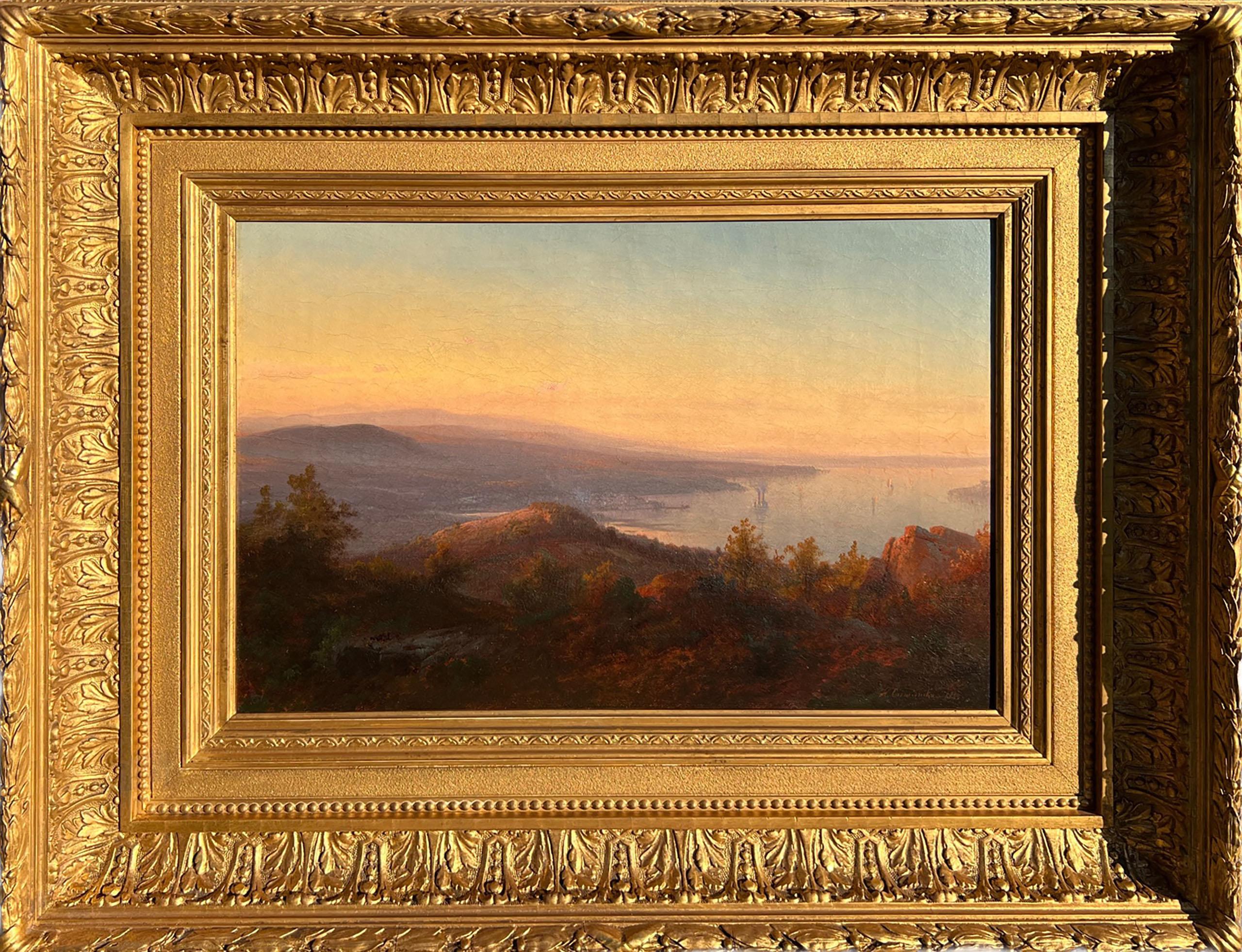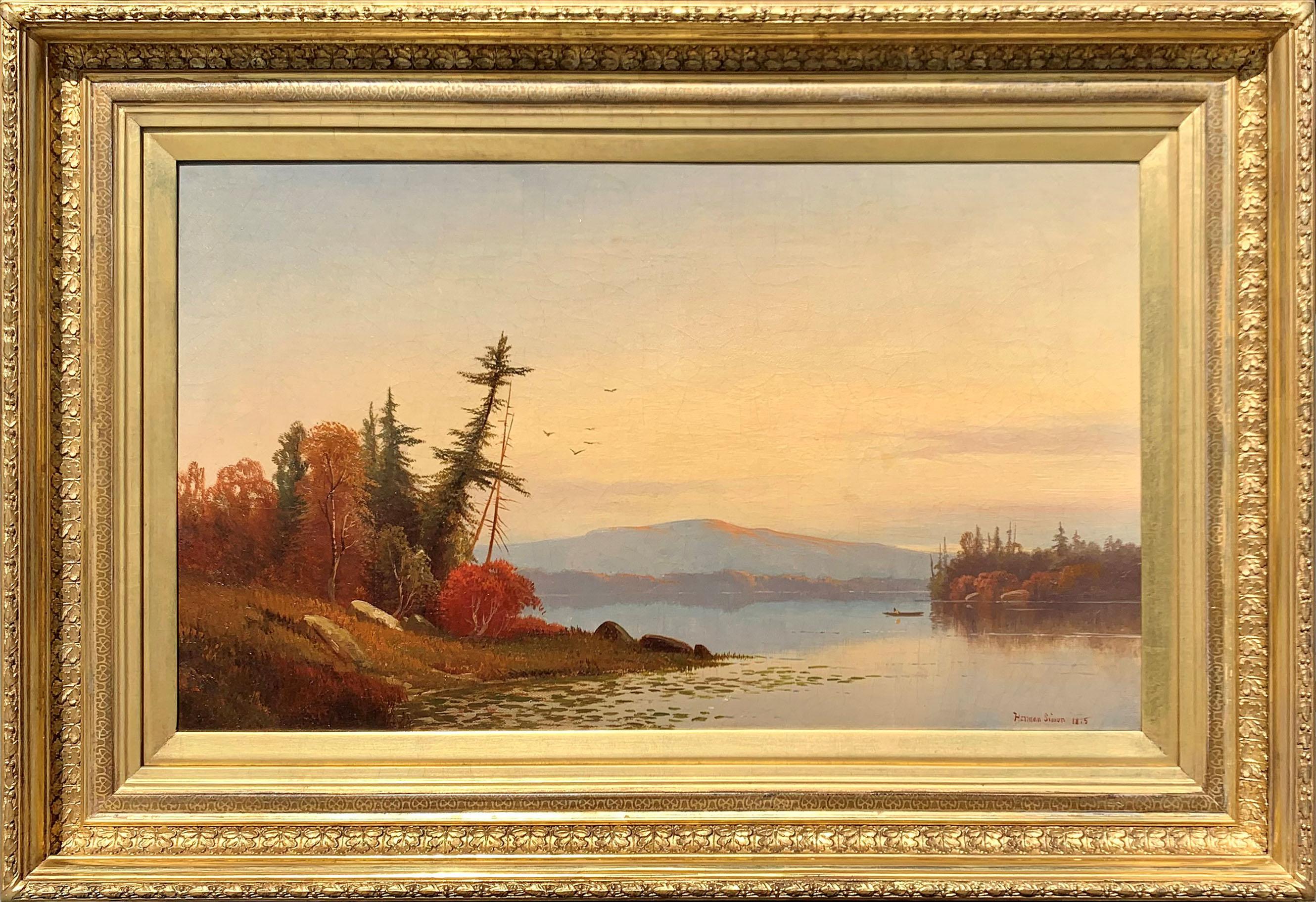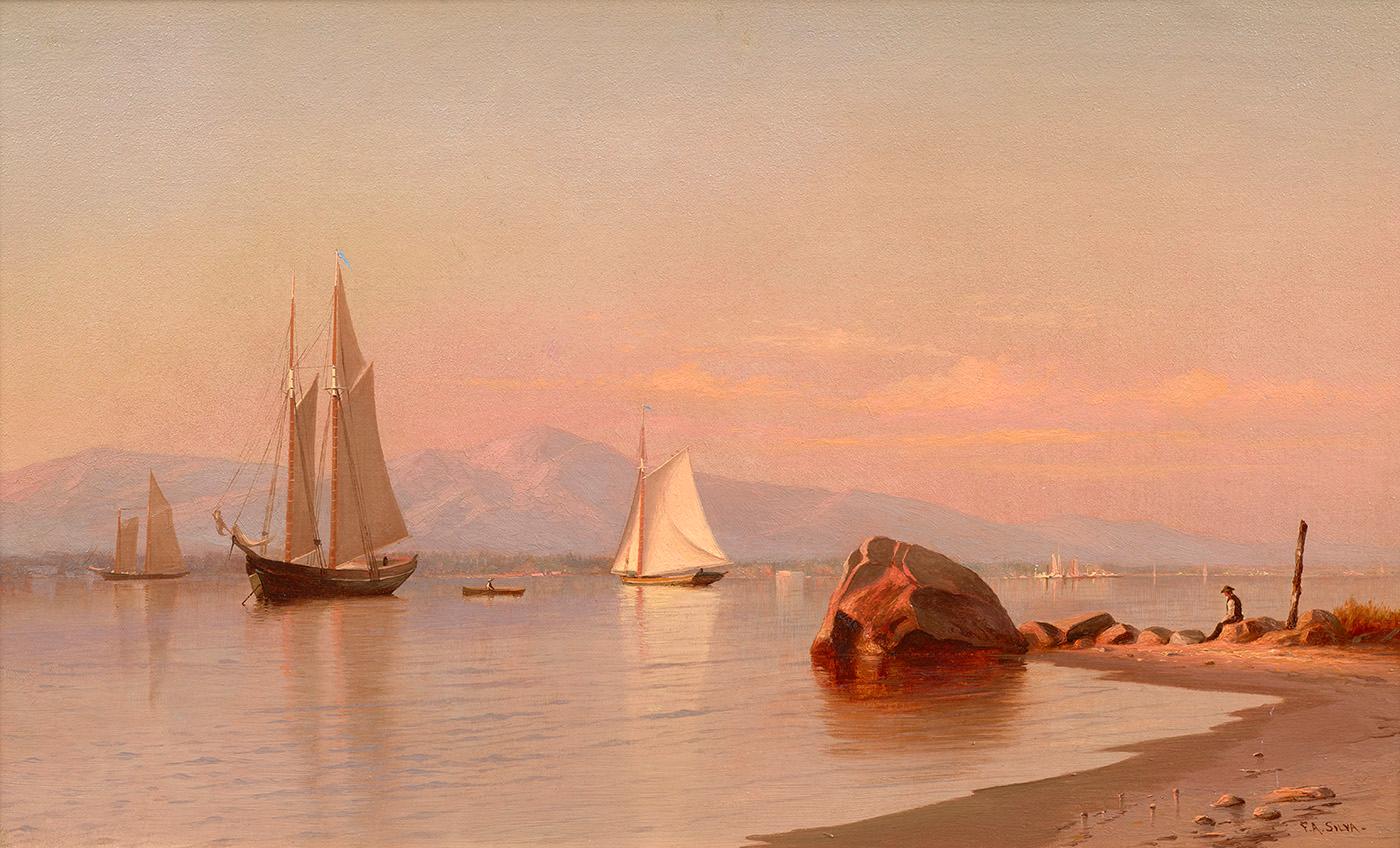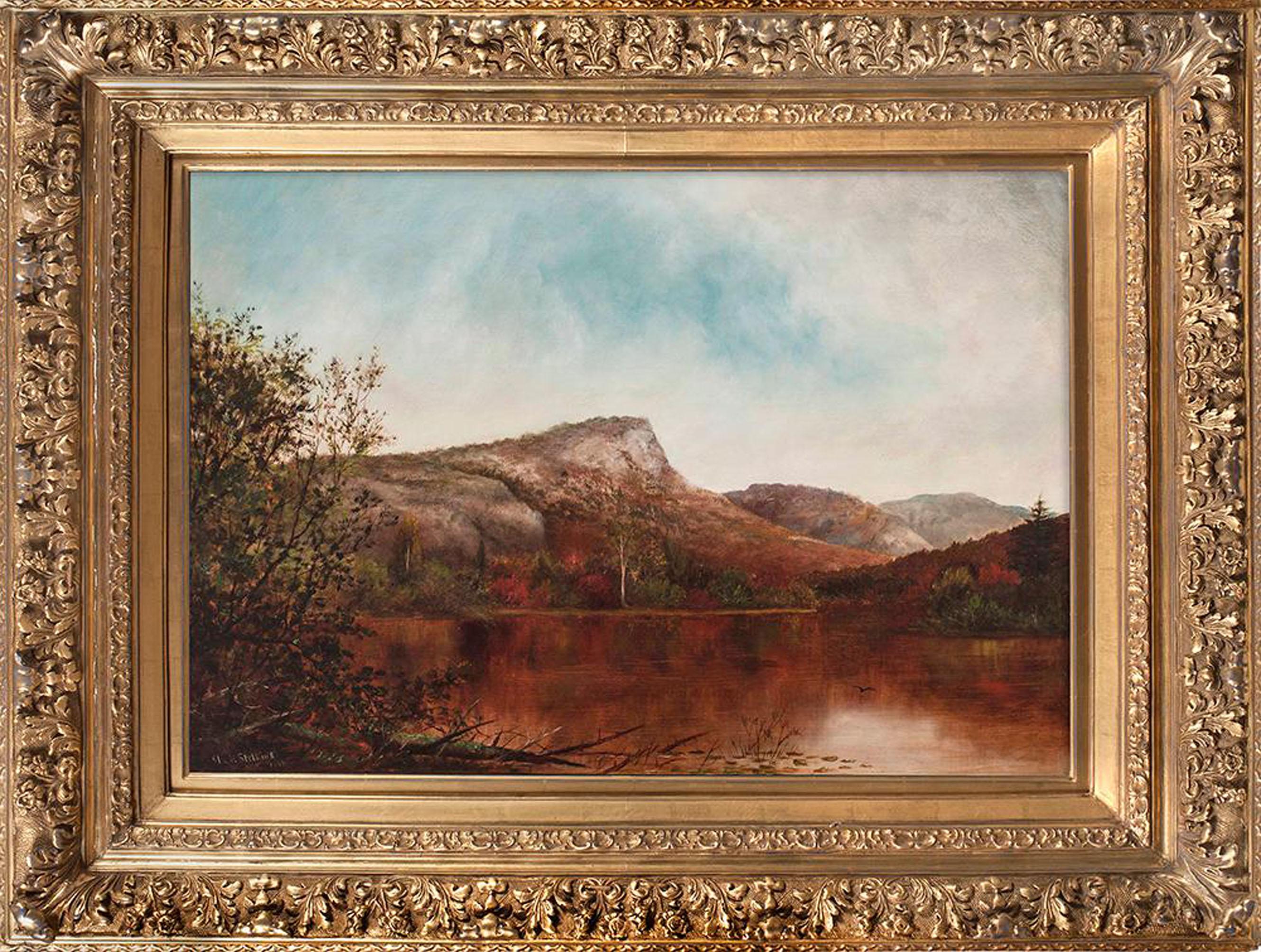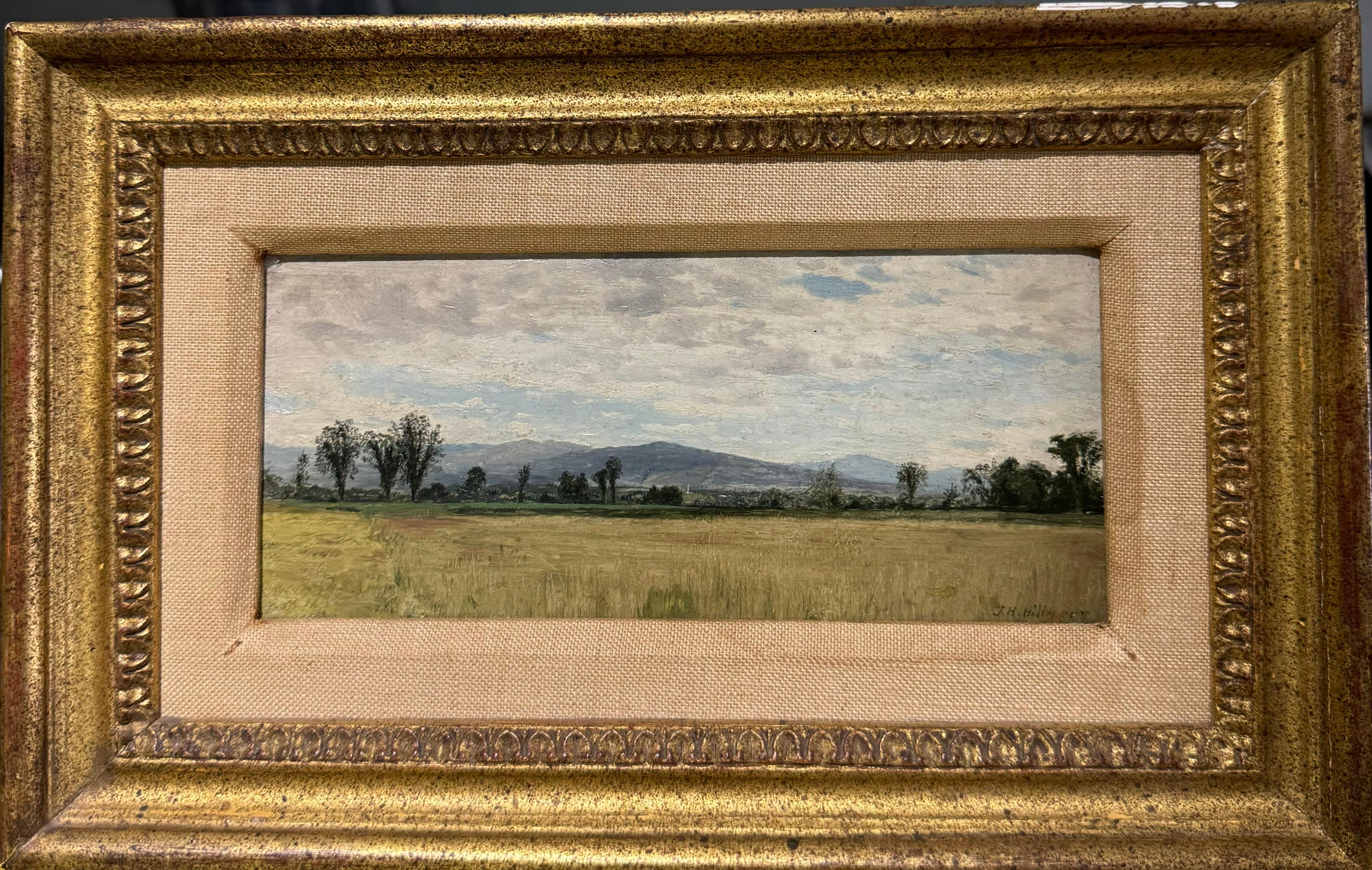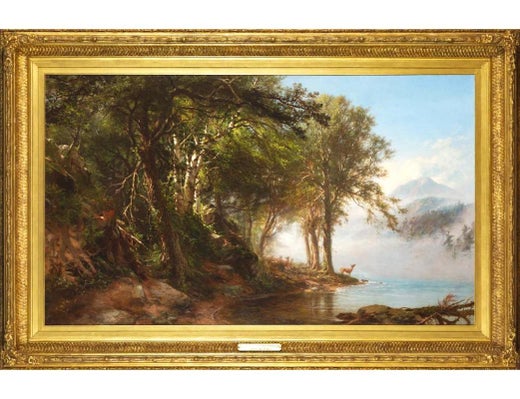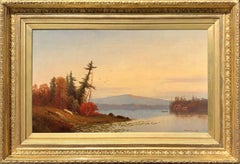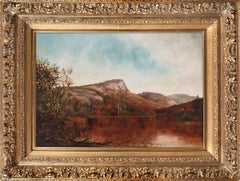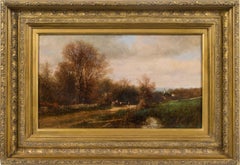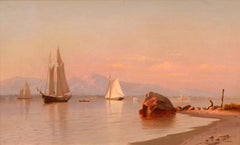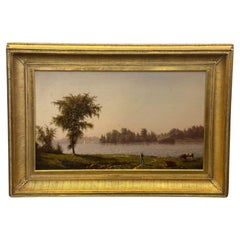Items Similar to View of Lake Champlain, c. 1857 by James MacDougal Hart (American: 1828–1901)
Want more images or videos?
Request additional images or videos from the seller
1 of 6
James McDougal HartView of Lake Champlain, c. 1857 by James MacDougal Hart (American: 1828–1901)c. 1857
c. 1857
$45,000
£34,096.03
€39,122.50
CA$63,322.26
A$69,608.59
CHF 36,583.08
MX$845,301.79
NOK 456,364.74
SEK 432,373.50
DKK 291,981.10
About the Item
JAMES MCDOUGAL HART (1828–1901)
View of Lake Champlain, c. 1857
Oil on canvas
26 3/16 x 36 1⁄4 inches
Signed lower center
Exhibition History: National Academy of Design, 1857 (cat. 488)
Provenance: F. W. Worth
Prominent amongst the second generation of Hudson River School painters, James McDougal Hart is known for his refined and intricately crafted pastoral scenes, often featuring grazing cattle. Born in Kilmarnock, Scotland in 1828, Hart immigrated with his family to Albany, New York when he was just two years old. His older brother, William Hart (1823–1894), and younger sister, Julie Hart Beers (1835–1913), also went on to become accomplished landscape painters. James’ future wife, Marie Theresa Gorsuch, was a still life painter, and their three children, Robert Gorsuch Hart, Letitia Bonnet Hart, and Mary Theresa Hart, all grew up to be painters as well. James Hart began his career, as had William, in a sign and carriage painter’s shop. Unlike his brother, James returned to Europe at the age of twenty-two to receive academic training. He studied briefly in Munich, and for three years with Johann Willhelm Schirmer (1807–1863) at the Düsseldorf Academy, a center of realist pedagogy that was equally influential for fellow Hudson River School painters, Worthington Whittredge (1820–1910), Eastman Johnson (1824–1905), Albert Bierstadt
(1830–1902), and William Stanley Haseltine (1835–1900).
Returning to the United States in 1853, Hart established his first studio in Albany. A few years later, he settled permanently in New York City, later moving to Brooklyn. In the 1870s, he and his brother opened studios in Keene Valley, New York, in the heart of the Adirondacks. Hart was elected an Associate of the National Academy of Design in 1857 and a full member in 1859, exhibiting his work there consistently over the next forty years, and serving as its Vice President from 1895 to 1899. He also exhibited at the Brooklyn Art Association, the Pennsylvania Academy of the Fine Arts, the Boston Art Club, the Mechanics Institute in Boston, the Corcoran Gallery of Art, the Art Institute of Chicago, the Centennial International Exposition of 1876 (the first official World’s Fair in the United States, held in Philadelphia), and the Paris Exposition of 1889.
In 1867, prominent art critic Henry Tuckerman observed that “an exquisite truth and grace [are] characteristic of his [Hart’s] pencil,” and praised his "Woods in Autumn" as “one of the finest contributions lately made to the list of American successes in this field of art.” Today, Hart’s paintings are in the collections of the Metropolitan Museum of Art; the Brooklyn Museum; the Museum of Fine Arts, Boston; Harvard University’s Fogg Art Museum; the Smithsonian Museum of American Art, Washington, D.C.; the Corcoran Gallery of Art; the Walters Art Museum, Balitmore, Maryland; and the Thyssen-Bornemisza Museum, Madrid, among others.
One could only hope to find themselves overlooking the majestic landscape that Hart has rendered in the exceptional, early large-scale, "View of Lake Champlain." The sky is a spectrum of color, suggestive of the rising sun, and fragments of light are reflected on the water below. The entire scene, with its lush trees and tranquil lake, appears to be untouched and unaffected by man with the exception of the peaceable sheep resting and grazing in the left foreground.
- Creator:James McDougal Hart (1828-1901, American)
- Creation Year:c. 1857
- Dimensions:Height: 26.19 in (66.53 cm)Width: 36.25 in (92.08 cm)
- Medium:
- Movement & Style:
- Period:
- Condition:
- Gallery Location:New York, NY
- Reference Number:1stDibs: LU2151211169442
James McDougal Hart
Hart was born in Kilmarnock, Scotland, and was taken to America with his family in early youth. His older brother, William Hart, was also a Hudson River School artist, as were his younger sister Julie Hart Beers and his two daughters, both figure painters, Letitia Bonnet Hart (1867 - Sept. 1953) and Mary Theresa Hart (1872–1942). Another niece, Annie L. Y. Orff, became an editor and publisher. In Albany, New York he trained with a sign and carriage maker— possibly the same employer that had taken on his brother in his early career. James later returned to Europe for serious artistic training, studying in Munich and as a pupil of Friedrich Wilhelm Schirmer at the Kunstakademie Düsseldorf. He is associated with the Düsseldorf school of painting. Along with most of the major landscape artists of the time, Hart based his operations in New York City and adopted the style of the Hudson River School. While he and his brother William often painted similar landscape subjects, James may have been more inclined to paint exceptionally large works. An example is The Old Homestead (1862), 42 x 68 inches, in the collection of the High Museum of Art in Atlanta, Georgia. James may have been exposed to large paintings while studying in Düsseldorf, a center of realist art pedagogy that also shaped the practices of Albert Bierstadt and Worthington Whittredge. Like his brother William, James excelled at painting cattle. Kevin J. Avery writes, "the bovine subjects that once distinguished [his works] now seem the embodiment of Hart's artistic complacency." In contrast with the complacency of some of his cattle scenes, his major landscape paintings are considered important works of the Hudson River School. A particularly fine example is Summer in the Catskills, now in the Thyssen-Bornemisza Museum in Madrid, Spain.
About the Seller
5.0
Recognized Seller
These prestigious sellers are industry leaders and represent the highest echelon for item quality and design.
Established in 2004
1stDibs seller since 2022
5 sales on 1stDibs
- ShippingRetrieving quote...Shipping from: New York, NY
- Return Policy
Authenticity Guarantee
In the unlikely event there’s an issue with an item’s authenticity, contact us within 1 year for a full refund. DetailsMoney-Back Guarantee
If your item is not as described, is damaged in transit, or does not arrive, contact us within 7 days for a full refund. Details24-Hour Cancellation
You have a 24-hour grace period in which to reconsider your purchase, with no questions asked.Vetted Professional Sellers
Our world-class sellers must adhere to strict standards for service and quality, maintaining the integrity of our listings.Price-Match Guarantee
If you find that a seller listed the same item for a lower price elsewhere, we’ll match it.Trusted Global Delivery
Our best-in-class carrier network provides specialized shipping options worldwide, including custom delivery.More From This Seller
View AllHudson River Landscape by American Artist Johann Hermann Carmiencke (1810-1867)
By Johann Hermann Carmiencke
Located in New York, NY
Painted by Hudson River School artist Johann Hermann Carmiencke, "Hudson River Landscape" is oil on canvas and measures 12 x 18 inches. The painting is signed and dated 1865 at the l...
Category
19th Century Hudson River School Landscape Paintings
Materials
Canvas, Oil
Sunset on the Hudson River by Hermann Simon (American, 1846-1895)
Located in New York, NY
Painted by Hudson River School artist Hermann Simon (1846-1895) , "Sunset on the Hudson River" is oil on canvas, measures 15 x 25 inches, and is signed and dated 1875 at the lower ri...
Category
19th Century Hudson River School Landscape Paintings
Materials
Canvas, Oil
View of South Pond, New York, 1879 by Ida H. Stebbins (American, b. 1851)
Located in New York, NY
Painted by Hudson River School artist Ida H. Stebbins (b. 1851), "View of South Pond, New York," 1879 is oil on canvas, measures 23 x 33 1/2 inches, and is signed and dated 1879 at the lower left. The work is framed in an elegant Barbizon style frame and ready to hang.
Ida H. Stebbins was born in January 1851 in Chelsea, Massachusetts to Mary and Isaac Stebbins, a teacher. Though scant records remain of Stebbins’ artistic training or career, various personal details of her life have been gleaned from contemporary newspapers and federal documents. By the time View of South Pond, New York was painted in 1879, she was living in Boston. Like many artists of her generation, Stebbins likely traveled throughout the Northeast region, gaining inspiration for her paintings from the landscape of New England and New York. Stebbins was likely visiting
upstate New York when she painted this sweeping view of South Pond and the surrounding mountains near Long Lake in the Adirondacks just south of Deerland. Here, Stebbins captures the stunning vermillion, burnt orange and brown tones of the autumn landscape with the style and precise rendering often seen in paintings produced by the Hudson River School.
Shortly after the completion of View of South Pond, New York, Stebbins married Frank H. Slack, a clerk, in her hometown of Chelsea on December 14, 1881 at the age of thirty. The couple moved to Hotel Comfort in Boston, where their son, Roland Stewart Slack was born on May 22, 1883. It seems likely that her husband died in the mid-1880s since on December 3, 1889, records indicate that Ida and Roland changed their last name back to her maiden name of Stebbins.
Roland Stewart Stebbins (1883-1974) inherited his mother’s interest in art, studying at the Pennsylvania Academy of the Fine Arts, Columbia University in New York, and the Art Students League of New York. He also studied at the Académie de la Grand Chaumière and the Munich Academy of Fine Arts. Today, he is remembered for his marine and genre paintings and for his legacy as a respected professor of art education at the University of Wisconsin, Madison.
On January 1, 1890, Ida married her second husband, Timothy Jarvis, in Somerville, Massachusetts. Their daughter, Ida Hazel Jarvis, was born soon after in 1893. However, the child suffered paralysis from a brain tumor...
Category
19th Century Hudson River School Landscape Paintings
Materials
Canvas, Oil
A Day in November, 1863 by James MacDougal Hart (American: 1828–1901)
By James McDougal Hart
Located in New York, NY
A prominent 19th century landscapist, Hudson River School painter James McDougal Hart's (1828-1901) A Day in November, 1863 is oil on canvas and measures 10.5 x 18 inches. The painti...
Category
19th Century Hudson River School Landscape Paintings
Materials
Oil, Canvas
Summer along the Boquet River, 1875 by Julie Hart Beers (American, 1835-1913)
By Julie Hart Beers
Located in New York, NY
Painted by Hudson River School artist Julie Hart Beers (1835-1913), "Summer along the Boquet River" is oil on canvas and measures 9 x 11 inches. It is signed and dated 1875 at the lo...
Category
19th Century Hudson River School Landscape Paintings
Materials
Canvas, Oil
Scene in the White Mountains by Alfred Thompson Bricher (American, 1837-1908)
By Alfred Thompson Bricher
Located in New York, NY
Painted by Hudson River School artist Alfred Thompson Bricher (1837-1908) , "Scene in the White Mountains" is oil on panel, measures 5.5 x 9.75 inches, and is signed and dated 1864 a...
Category
19th Century Hudson River School Landscape Paintings
Materials
Oil, Panel
You May Also Like
View on the Hudson, the Catskills in the Distance
By Francis Augustus Silva
Located in New York, NY
Signed lower right: F.A. SILVA.
Category
Late 19th Century Hudson River School Landscape Paintings
Materials
Canvas, Oil
Housatonic River at Cornwall
By John William Casilear
Located in Milford, NH
A fine Connecticut river landscape by American Hudson River artist John William Casilear (1811-1893). Casilear was born in New York City, began his study with master engraver Peter M...
Category
1860s Hudson River School Landscape Paintings
Materials
Canvas, Oil
1857 American Hudson River Rockland County Landscape Painting KENNEDY Gallery
By John Henry Hill
Located in New York, NY
John Henry Hill
1839-1922
Signed lower right
Dated: 1857
Sight size: 3 3/4 x 7 1/2 inches
Overall size: 7 3/4 x 11 1/2 inches
oil on panel
Good condition
Kennedy Gallery Label Verso
...
Category
1850s Hudson River School Landscape Paintings
Materials
Wood Panel
'Hudson River' Oil on Canvas by John Williamson, 1865
By John Williamson
Located in Los Angeles, CA
Traditional oil on canvas painting by John Williamson, titled 'Hudson River' and dated 1865, depicts a fisherman with cattle next to the river. Protected by a giltwood frame.
Dimensi...
Category
Antique 1860s Paintings
Materials
Canvas, Wood
Antique Rare American Hudson River School Original Frame Landscape Oil Painting
Located in Buffalo, NY
A stunning 19th-century Hudson River School landscape painting, beautifully framed in an exquisite period giltwood molding.
Category
1890s Hudson River School Landscape Paintings
Materials
Canvas, Oil
$956 Sale Price
20% Off
19th Century Hudson River School Landscape after Richard Goodwin
Located in Soquel, CA
Charming Hudson River school antique oil painting of a sailboat on a lake, circa 1880-90. Signed "R. Labarr." after Richard LaBarre Goodwin...
Category
1880s Hudson River School Landscape Paintings
Materials
Canvas, Oil
$1,218 Sale Price
35% Off
More Ways To Browse
Oil Paintings By C Walters
1901 Oil
William Hart
River View Painting
19th C Landscape Painting
Hudson River Painters
Hart Oil Paintings
Lake Champlain
Mary Bonnet
Vintage Rockport
Malibu Art
Antique Beach Painting
Dark Landscape Art
Newport Rhode Island
Oil Painting Resting
Sunrise Landscape Painting
Trinity College
Mid Century Swedish Paintings
